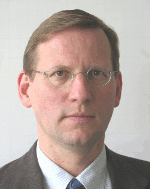 |
|
Biography
Hans Kosina received the Diplomingenieur degree in electrical engineering and PhD from the Technische Universität Wien in 1987 and 1992, respectively. He was with the Institute of Flexible Automation at the Technische Universität Wien for one year and then joined the Institute for Microelectronics, where he is currently an Associate Professor. He received the venia docendi in microelectronics in 1998. In the summer of 1993, he was a visiting scientist at Motorola Inc., Austin, Texas, and in the summer of 1999, a visiting scientist at Intel Corp., Santa Clara, California. Dr. Kosina served as a Technical Program Committee member in the IEEE International Workshop on Computational Electronics in 2003 and 2004 and was the chairman of the ''11th International Workshop on Computational Electronics'' held in Vienna in May 2006. He has served as the Associate Editor of the IEEE Transactions on Computer-Aided Design of Circuits and Systems since January 2004. His current research interests include the device modeling of semiconductor devices, nanoelectronic devices, organic semiconductors and optoelectronic devices, the development of novel Monte Carlo algorithms for classical and quantum transport problems, and computer-aided engineering in ULSI-technology.
Electronic Transport in Semiconductor Devices and Nanostructures
Depending on the characteristic length scales of a semiconductor device, carrier transport has to be modeled either classically or quantum mechanically. Over the last year, we made contributions to the modeling of both transport regimes.
The most rigorous description of quantum transport is given by non-equilibrium Green's functions (NEGF). Specifically, we have adapted the NEGF numerical approach into a formalism capable of handling triangular meshes to resolve arbitrarily shaped geometries, anisotropic effective masses and carrier scattering in a numerically tractable way. This expanded NEGF algorithm was then integrated into the existing Vienna Schroedinger-Poisson (VSP) solver.
A key application area for this quantum solver throughout the year has been the field of nanostructured thermoelectric materials. Using VSP, we have been able to study both the potential benefits of proposed nanostructuring strategies and the fragility of any efficiency improvements in the face of the natural random imperfections that would be expected in any realistic structure. More specifically, our work has highlighted the potential for thermoelectric enhancement in low-dimensional superlattice structures but has also identified some of the key culprits that can destroy this enhancement in real experiments.
Quantum transport models of lesser complexity than NEGF can be formulated in terms of the von Neumann equation and the Wigner equation. These are linked by a transformation from the density matrix to the Wigner function. An intermediate step in this transformation is the introduction of characteristic coordinates. We study properties of the density matrix as a function of the characteristic coordinates and its numerical application to quantum transport. The stationary von Neumann equation takes on its characteristic form, which we call the sigma equation. It can be transformed into a two-dimensional integral equation of the Volterra type. Existence and uniqueness of the solution can be proved similarly to the case of ordinary differential equations. Scattering can be included in the relaxation time approximation using the same models as in the finite difference Wigner method. All operators in this equation can be sparsely discretized, which we consider the main advantage over the finite difference Wigner method. The equation can be solved by a shooting method. In this way, a big system matrix does not need to be stored. Furthermore, the method can easily be parallelized.
With respect to classical transport, we continued the development of the Monte Carlo device simulator Vienna Monte Carlo (VMC). It is well accepted that electron-electron (e-e) scattering has a significant influence on the high-energy tail of the distribution function. Because of its complexity, this scattering mechanism often gets neglected or roughly approximated. Most of these approximate models predict an increase in the distribution function at very high energies.
In order to investigate whether this behavior is physical, we implemented an e-e scattering model in the full-band simulator VMC with as few approximations as possible. The total scattering rate for a one-particle simulation is obtained by summing over all possible initial and final states of the partner electron. To model the effects of mixing the channel hot electrons with the cold electrons in the drain, the partner electrons are assumed to obey the equilibrium distribution of the drain. Out of the two summations, one summation needs to be carried out numerically taking into account the tabulated band structure.
Our results clearly show an enhancement of the high-energy tail of the distribution function (Fig. 1). This enhancement is however less pronounced than predicted by the deterministic Boltzmann solver Vienna Spherical Harmonics Expansion, which relies on additional approximations. To tackle the problem of rare events, we evaluate the distribution function point-wise using a backward Monte Carlo method.

Fig. 1: Energy distribution at three positions along the channel 65 nm nMOSFET in the on-state. E-e scattering increases the high-energy tail (solid line) as compared to the Maxwellian tail (dashed line), resulting from electron-phonon scattering only.



